Marbled porcelain tiles: types and sizes

Today it has become popular to use natural stones when decorating an apartment. They are durable and beautiful, but they have a high price, so not everyone can afford it. In this case, marble-like porcelain stoneware can be an analogue.
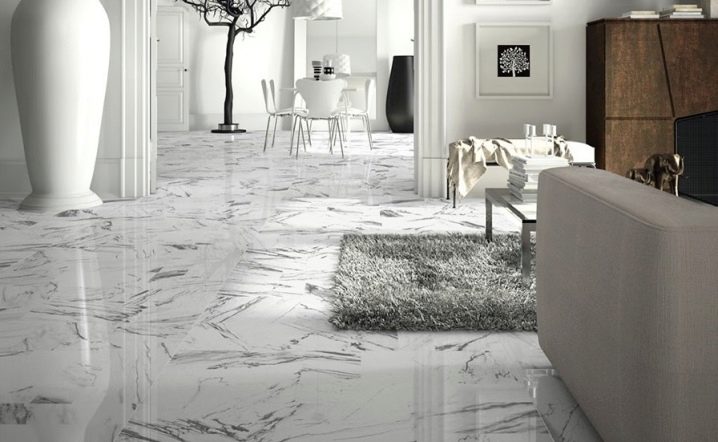
Peculiarities
This product is an excellent material for decorating not only floors, but also walls.
The main qualities of porcelain stoneware are:
- Strength. Ceramic tiles can withstand both mechanical stress (falling objects, rearranging furniture) and chemical manipulations;
- The surface is resistant to any type of detergent, including abrasive agents;
- Easy cleaning. The tiles do not require complex maintenance. It is easy to wash and clean from dust and dirt;

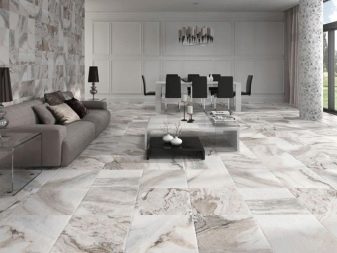


- Aesthetic appearance. With marbled tiles, you can create a variety of design masterpieces that will fit into any interior;
- Variety of assortment. Porcelain stoneware can be plain, with patterns or patterns. This will allow each buyer to find the option they want;
- Availability. This applies to both distribution and price;

- High wear resistance;
- Slip resistant;
- Resistant to high and low temperatures. Such a surface can be installed next to electric heaters. Suitable for use in the decoration of street houses, verandas or paths on the site;
- Resistant to high humidity. Porcelain stoneware is often chosen for finishing a bathroom, bath or sauna.


The degree of wear resistance is determined in a rather interesting way: using an abrasive wheel that rotates on the surface.
Depending on the number of revolutions that the circle made, and the appearance of abrasions on the tile, the following degrees are assigned:
- 150-500 (PEI I);
- more than 600 (PEI II);
- 1500 (PEI III);
- more than 1500 (PEI IV).

Due to the degree of wear resistance, you can find out not only the approximate service life, but also possible placement options in the premises:
- Category 1 - most often used for a bedroom or bathroom;
- Category 2 - living room, bedroom or bathroom;
- Category 3 - kitchen, living room, hallway;
- Category 4 - entrance hall, garden paths, office room.




Another important factor when choosing a product is the degree of slip resistance.
It is determined by the level of friction:
- R9 - such a product is suitable for a hallway, living room;
- R10 - tiles can be used in rooms with variable humidity: in the kitchen, in the toilet, in warehouses;
- R11-R 13 - tiles are designed for rooms with high humidity: bathroom, toilet, industrial warehouses.

Resistance to chemical attack is an important indicator, especially when choosing a surface for a kitchen or bathroom, since such rooms are most often cleaned with abrasive products.
Such an indicator is determined by changing the integrity of the surface after exposure to the funds:
- AA is the most durable type of tile, as there is no change;
- A - also refers to a resistant type of product, but at the same time there is a slight deformation;
- B - on such a tile, the changes become more noticeable;
- C - this degree indicates that the tile is not resistant to the effects of chemicals, since partial deformation occurs;
- D - this type of tile is completely unsuitable for this treatment, since the appearance is completely lost.
In addition to technical characteristics, when choosing a finishing surface, you should pay attention to the size and type of material.

Types and sizes
Marble tiles are often used not only for flooring, but also for walls, and also as a decorative element. Depending on the type of surface, the following types are distinguished:
- Matte tiles. It does not undergo polishing, so its surface is less smooth and safer.
- Glossy tiles undergoes polishing, so its surface has a pleasant gloss and presentable appearance. Moreover, such material is considered more traumatic and it is undesirable to use it in a room with high humidity;
- Glazed option it is considered a decorative wall material, since its surface has poor resistance to mechanical and chemical influences. The coating of such a tile has a light glass dusting, due to which the finishing material looks chic and noble;
- Satin-finished tiles. Has a thin surface layer of mineral salts. The surface is less smooth, but at the same time has a pleasant, calm sheen;
- Embossed tile has a surface that accurately imitates natural marble. As a rule, this option does not have a smooth and shiny top coat.


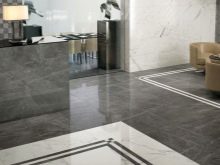


The classic form of ceramic tiles is square with dimensions 40x40, 45x45 or 60x60 cm. There are also products with the following dimensions: 1200x600, 1200x1200, 1200x2400, 3000x1000, 1800x900, 600x1200 mm. These tiles are considered large format and are most often used for large areas or for outdoor decoration. Products with dimensions 60x60 cm are used for wall and floor decoration in residential premises and public places. The slabs made in a seamless manner of this size create a harmonious and uniform image of the room.
Since this material is resistant to temperature extremes and does not absorb moisture, it is used to decorate the outside of the house. Depending on the desire and the design of the building, you can select both large-format options and small-sized slabs. So, for example, for the original laying of garden paths, you should use small relief tiles and grout in a contrasting color. This method will allow you to achieve a visual resemblance to a path lined with natural stone.

Color solutions
Marble is a mountain stone that has many shades. The entire color palette of natural marble can be recreated on porcelain stoneware. Common stone colors are white and black, gray and beige, pink and red, green and brown, and all shades of blue.
White porcelain stoneware is a versatile finishing material bedrooms, kitchen and living room. It will look harmoniously in any interior style. Another positive quality of this color is the visual expansion of the space, so designers most often use white tiles in apartments with a small area.
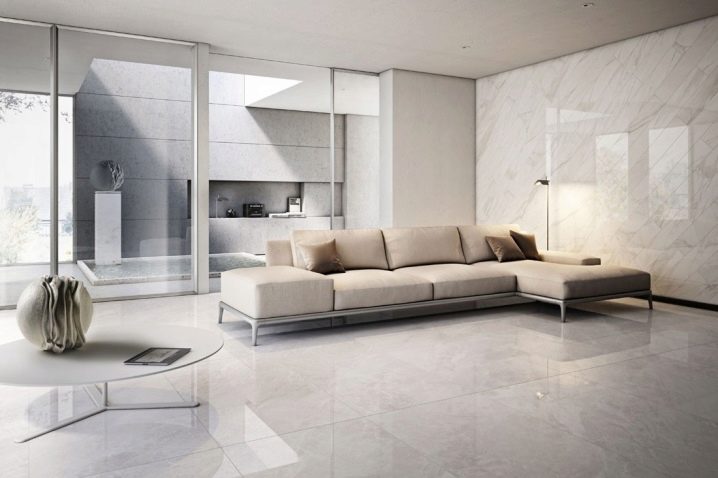
Black porcelain stoneware looks stylish and luxurious, but when facing walls or floors in this color, you should not use pure black tiles - it will look gloomy and uncomfortable. It is better to dilute this design with light-colored slabs. The material of this color can dominate in the interior of modern style, but in the classic interior it can also be present only as details or individual inserts.

The gray, beige and brown colors of the slabs are suitable for flooring. On the walls, such porcelain stoneware is best done with inserts or lay out a drawing, shape, ornament. These warm-toned colors will look great in the living room and bedroom.


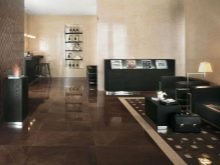
Red is an active option, so products of this color are inappropriate to use in a bedroom or children's room. It is better to use red porcelain stoneware with an interior in calm and light colors to create contrast, highlight certain areas of space.

Shades of green and blue best represent the natural marble palette. Therefore, such plates are used to decorate offices and office premises to create a chic and business atmosphere. In residential buildings, these slabs are also used, and most often they can be found in the bathroom, hallway, and sometimes in the kitchen. A varied palette of colors allows board manufacturers to improve in their business.

Manufacturers
At the moment, the leaders in the production of marbled ceramic tiles are countries such as Italy, Spain and China.
Chinese porcelain stoneware is renowned for its unique resemblance to natural marble. Sometimes it is difficult to distinguish it even for a specialist.
The Spanish production under the brand name Absolut Keramika uses a metal oxide that, when melted, creates stripes like on natural stone. From this, the texture of porcelain stoneware becomes similar to marble and has an attractive appearance.

The Italian manufacturer Acif is famous for the variety of types and excellent technical characteristics of the boards. Products are made only from high quality raw materials and using the latest technologies, which creates a fairly durable and resistant porcelain stoneware.
Each manufacturer tries to make their product better and more attractive, using innovations in technology and raw materials production for this. Regardless of the country of manufacture, it can be noted that marble effect porcelain stoneware is an economical, practical and presentable finishing material.

You can find out even more about the benefits of porcelain stoneware in the next video.













The comment was sent successfully.